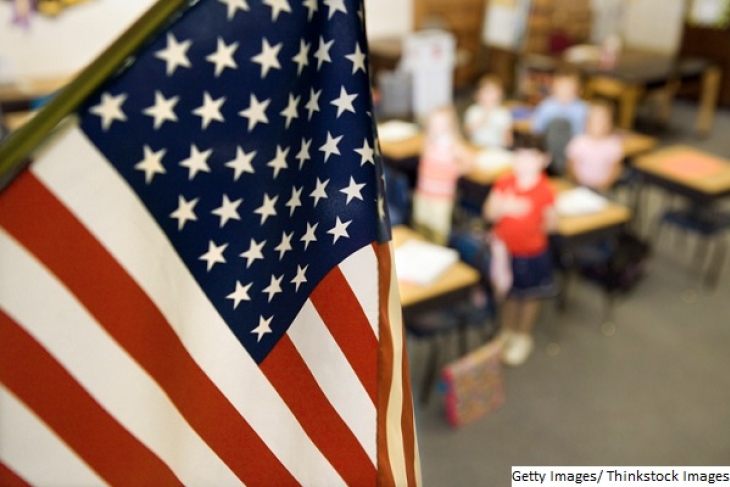A year ago I made an informal study of the mission statements of the one hundred largest school systems in the United States. I was curious to see whether the public purpose of public education—preparing children for citizenship and self-government—is top of mind when those who run those systems ask themselves, “What exactly is our purpose here?”
Unsurprisingly, it's not. About 60 percent of those big districts, collectively responsible for more than eleven million children, made no mention whatsoever of civics or citizenship. But it got a lot worse: The words “America” and “American” appeared zero times in one hundred school mission statements. Neither did “patriotic” or “patriotism.” However, “global” appears in the statements of twenty-eight districts—usually in phrases like “global society,” “global economy” or “global citizens.” What are we to make of that?
The public mission of education in America's schools (as distinct from the private and personal ends of college and career readiness) seems suddenly relevant. Writing in The Atlantic, Rick Kahlenberg asks whether the election of Donald Trump represents a “Sputnik moment” for civic education, forcing us to confront how badly we have failed “at what the nation's founders saw as education's most basic purpose,” namely preparing our children for reflective and capable self-government. “Just as Soviet technological advances triggered investment in science education in the 1950s,” Kahlenberg writes, “the 2016 election should spur renewed emphasis on the need for schools to instill in children an appreciation for civic values and not just a skill set for private employment.”
The key word in that sentence is “should.”
In a fortuitous bit of timing, the College Board last week released its redesigned framework for its Advanced Placement U.S. Government and Politics curriculum. Officials with the AP program are justifiably pleased with the enhanced sophistication of the new course framework, which replaces a two-page top-line content summary with a framework detailing the political-science skills and practices needed to help students “analyze, compare, interpret, and communicate political information.” But I like AP Government (I taught a homegrown version at a Democracy Prep charter high school) for an even simpler reason: Unlike most Advanced Placement classes, AP Government has no prerequisite. That means schools and districts that see the depressing spectacle and aftermath of the 2016 campaign as a sphincter-check moment—sorry, a Sputnik moment—have a virtually off-the-shelf means of getting back into the civic education game in earnest.
AP Government is already the most commonly taken civics course in the country. But that's like being the most popular show on PBS. At present, roughly one in ten U.S. high school graduates has taken the class. Though that's twice as many as five years ago, it leaves more than ample room for that number to double and redouble again.
Literacy, not content knowledge, is the most significant hurdle to widespread adoption of AP Government at present. The new framework includes a set of nineteen Supreme Court cases and nine foundational documents, from Federalist No. 10 to Martin Luther King, Jr.'s “Letter From Birmingham Jail.” The dense formal language and archaic structure of nineteenth and eighteenth century language can render many of these a heavy lift for many high schoolers. Students are expected to read those complex texts and write about them thoughtfully. “It does require foundational skill in reading and writing that don't allow us to say ‘Every student in the country will earn college credit through this course,’” according to Trevor Packer, who runs the AP program. “But the engagement with the content of a good American civics course is something that we believe all American students would benefit from.” Packer promises that the College Board will encourage schools to provide “open access” to AP Government. That's a fine start.
A higher hurdle to widespread adoption might be instructional talent. Schools and teachers and the nation at large might be full of passionate intensity about politics right now, but the rueful joke among civics nerds is that every teacher of this subject in the country has the same first name: “Coach.” Indeed, the lack of history and civics subject matter expertise among public-school teachers has surely contributed as much to the discipline's decline as any factor. Vague or nonexistent state academic standards and graduation requirements in civics and citizenship haven't helped. Curriculum-narrowing, driven by standardized testing of reading and math, was the final nail in the coffin. If this sounds like hyperbole, check the NAEP testing data on civics and history: Fewer than one in four eighth graders score at or above proficient.
If a new seriousness about civic education takes root and AP Government becomes much more widely taught, there will surely be heated debate about bias. Packer argues that the enhanced framework makes it less likely that teacher bias—right or left—will creep in to the class. AP has enlisted the National Constitution Center to prepare articles for students showing both sides of controversial cases like Roe v. Wade and Citizens United, demonstrating where there was bipartisan agreement, and where there were differences. “We think that may move teachers who may not be centrists or nonpartisans themselves in their approach to curriculum and instruction much closer to the center than they have been,” says Packer. Fears of teacher bias are not misplaced and surely make district officials gun-shy about any political course content, but that squeamishness is a luxury we can no longer afford.
If anything, we have likely reached a fish-or-cut-bait moment for civics education in America. If we can't commit to restoring the public purpose of public education now, we should simply stop talking about it and settle for nothing but college and job readiness—and resign ourselves to our poisoned national politics.
Editor’s Note: This article originally appeared in a slightly different form in U.S. News and World Report.

